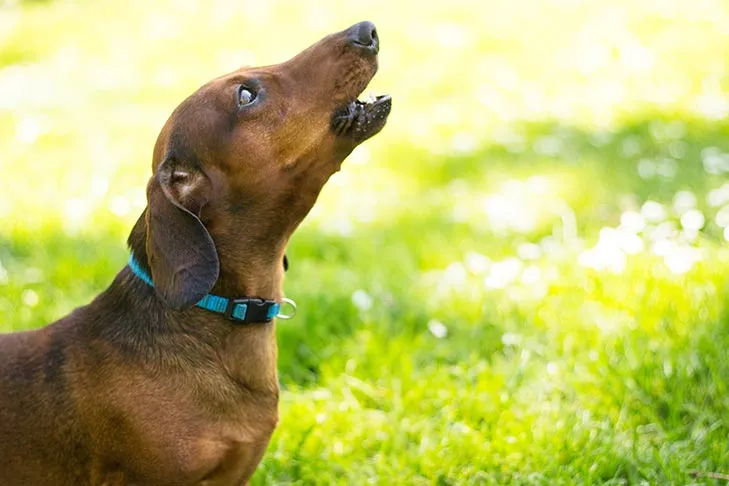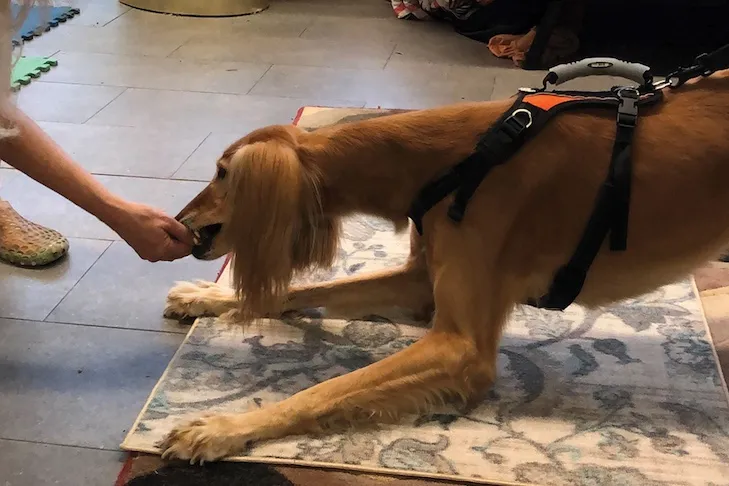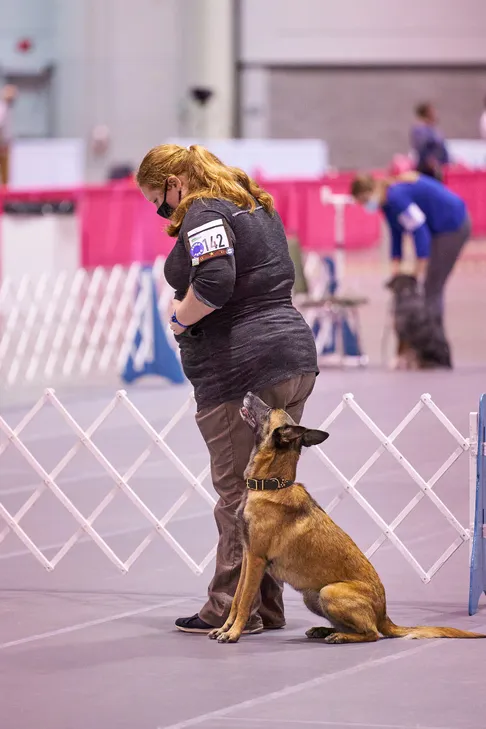Teaching your dog new tricks is not just a fun way to bond; it’s also a fantastic method to mentally and physically challenge them. Advanced tricks can impress your friends and family, but more importantly, they contribute to your dog’s overall well-being and can even lead to earning official titles. With patience, dedication, and the right approach, you can guide your canine companion through a rewarding learning experience that strengthens your connection and showcases their intelligence. This guide provides comprehensive steps on essential Tricks To Teach Your Dog And How to achieve mastery.
To embark on this exciting training journey, you’ll need a few basic supplies: plenty of high-value dog treats to keep your furry friend motivated, and their favorite toys if they respond well to play as a reward. A clicker can also be incredibly useful for marking the exact moment your dog performs the desired behavior, ensuring clear communication. Always choose a quiet, distraction-free environment to maximize focus during your training sessions. Remember, consistency and positive reinforcement are key to success when teaching your dog new skills. For more inspiration on what to teach, check out these fun and easy tricks to teach your dog.
How to Teach Your Dog to Catch
Teaching your dog to catch is a highly rewarding trick that engages their coordination and responsiveness. Begin by having your dog sit or stand directly in front of you. Capture their attention by holding a treat. With a gentle, underhanded toss, send the treat towards their mouth. If your dog successfully catches the treat, immediately offer enthusiastic praise. If they miss, try to quickly pick up the treat before they can eat it off the floor and try again. This helps them understand that catching is the desired action.
Repeat this process several times during each short training session. As your dog consistently catches tossed treats, gradually introduce lightweight, small toys they enjoy. When they successfully catch a toy, provide ample praise and follow up with a delicious treat. This progression helps generalize the catching behavior from food to objects, making the trick more versatile and engaging.
How to Teach “Under the Bridge”
“Under the bridge” is a charming trick where your dog crawls underneath your raised legs. To begin, sit on the floor with your knees bent and raised, forming a triangular “bridge.” Ensure you have irresistible treats or a favorite toy ready. Position your dog on one side of your body. Hold the treat or toy in your hand on the opposite side, reaching it under your legs to allow your dog to sniff it.
Slowly lower the treat or toy towards the ground, guiding it under your legs. As your dog follows the lure, they will naturally lower their body and crawl through. The moment they emerge on the other side, praise them enthusiastically and reward them with the treat or toy. After a few repetitions, introduce a verbal cue such as “under” or “bridge” as they move. Once your dog reliably performs the trick with the verbal cue, you can start to fade out the lure, eventually relying solely on the verbal command. This skill is a fantastic way to build your dog’s confidence and body awareness, making it one of the easy tricks to teach your dog.
How to Teach Your Dog to Speak
Teaching your dog to “speak” can be both useful and entertaining. The most straightforward method involves capturing, where you identify and reward a naturally occurring behavior. Have treats readily available. The next time your dog barks out of excitement, mark that specific moment with a chosen verbal cue, like “talk” or “speak,” and immediately give them a treat. A clicker can be particularly effective here, as it precisely marks the desired behavior, helping your dog understand what earned the reward.
 Dachshund howling or barking in a yard
Dachshund howling or barking in a yard
After several repetitions of marking and rewarding, your dog will begin to associate the verbal cue with barking. To avoid encouraging excessive barking, once your dog grasps the concept, only reward them when they bark specifically in response to your cue. This teaches them control and helps differentiate between appropriate and unnecessary barking.
How to Teach Leg Weaves
Leg weaves are an impressive trick where your dog gracefully weaves through your legs in a figure-eight pattern. Start in a safe, open area without a leash to prevent entanglement. Stand with your legs wide apart and your dog in front of you. Hold a treat in one hand behind your legs, using it to lure your dog through and around your legs. Bend your knees slightly as you guide them. As your dog passes between your legs, offer praise and a treat.
Once they are comfortable with this, use another treat to guide them through your legs and around one leg until they return to their starting position in front of you. Allow them to lick or nibble the treat to keep them engaged and in position. When they complete the full half-weave, praise and reward. Repeat this process, teaching them to weave around the other leg. When your dog consistently follows the lure through both sides, it’s time to link the movements into a continuous figure-eight.
Begin by luring your dog through your legs and around your right leg, then immediately around your left leg, before giving a treat. Gradually, you can fade out the treat lure, using an empty hand to guide them. Once they follow your empty hand, introduce a verbal cue like “weave” or “legs.” With more practice, your dog will learn to recognize your bending-knee body language as a physical cue, allowing you to eventually phase out the hand lure. Once they’ve mastered weaving while you’re stationary, introduce movement by taking slow, large steps as you cue them to weave. Reintroduce the treat lure initially to build confidence with movement, then slowly fade it out as your dog gains proficiency, moving faster with smaller steps to perfect the trick.
How to Teach Your Dog to Shake Hands
Teaching your dog to shake hands is a classic and delightful trick. Start by holding your hand out to your dog at their paw level. Initially, ignore any sniffing or licking. The moment your dog paws at your hand, mark that specific behavior with praise or a click, and immediately give them a treat. Repeat this sequence until your dog reliably paws at your hand.
 Australian Shepherd learning to give paw outdoors
Australian Shepherd learning to give paw outdoors
Next, work on increasing the duration of their paw on your hand. Wait until their paw rests on your hand for a second or two before clicking/praising and rewarding. Gradually extend this duration as your dog understands what is expected. Once they consistently place their paw on your hand and wait for the reward, introduce a verbal cue such as “shake” or “hello.” At this stage, you can also flatten your hand and hold it vertically, mimicking a human handshake, with the treat in it. Begin to introduce a gentle, up-and-down shaking motion with your hand before rewarding your dog. For more impressive maneuvers, consider teaching your dog some of the top 10 tricks to teach your dog.
How to Teach Your Dog to Say Yes and No
This advanced trick allows your dog to seemingly answer “yes” or “no” to your questions, a truly impressive feat. To teach “yes” (a head nod), hold a high-value treat in a closed fist (or use another distinct hand signal). Slowly move your hand, holding the treat, up and down. As your dog follows the lure and nods their head, reward them with the treat.
Once your dog consistently follows your fist’s up-and-down motion, try performing the action with an empty hand. When your dog nods, praise them and then deliver a treat with your other hand. With practice, the closed fist will become the physical cue for nodding, and you can eventually phase out the hand motion.
To teach “no” (a head shake), use a similar luring technique but with a different hand signal, such as a closed fist with your pointer finger extended. Move your hand slowly from side to side. As your dog follows your hand, their head will appear to shake. When they move their head in this manner, praise and treat. With consistent practice, the extended finger will become the physical cue for shaking their head. These are certainly some cute easy tricks to teach your dog.
How to Teach Your Dog to Bow
The “bow” is an elegant trick that involves your dog lowering their front half while keeping their rear end up. Begin with your dog standing in front of you. Capture their attention with a treat in your hand. Slowly lure their nose down between their front legs and back towards their chest and belly. As your dog follows the treat, they will naturally move into the bow position. Praise and treat your dog immediately. Then, toss a treat away from them to encourage them to stand up, preventing them from simply flopping into a “down” position. Repeat this over several short practice sessions.
If your dog tends to go into a full “down” rather than a bow, a helpful tip is to lightly place a hand or a finger on their stomach, just below the loin. This subtle cue can help them understand you’re not asking for a full lie-down.
 Dog in a bow position
Dog in a bow position
Once your dog reliably follows the food lure into a bow, begin to lure them with an empty hand. Reward them with a treat after they achieve the bow position. When they follow the empty-hand lure consistently, introduce a verbal cue like “bow” or “fancy.” With practice, your dog will build the strength and coordination to hold the bow longer. Over time, you can also evolve the physical cue for this trick, perhaps even bowing or curtsying yourself to signal the desired action.
How to Teach Your Dog to Make a Circle (Spin)
Teaching your dog to spin in a circle is a simple yet engaging trick. Get your dog’s attention with a treat or a favorite toy. Hold the lure just above their nose and slowly move your hand in a large circle. As your dog follows the treat or toy, they will naturally walk in a circle. Praise and treat your dog immediately upon completing the circle. After a few repetitions, when your dog consistently follows the lure, introduce your verbal cue of choice, such as “spin,” “twirl,” or “around.”
Next, use the same technique to lure your dog in the opposite direction. Once they consistently follow your lure in the second direction, add a different verbal cue if desired, or use the same one but specify direction. When your dog consistently responds to your cue in both directions, you can transition to using the circular hand motion without a treat in your hand while giving your verbal cue. When your dog spins, remember to praise and treat. This builds excellent body awareness and response to cues, making it one of the most popular tricks to teach your dog easy.
How to Teach Your Dog to Play Peekaboo
The “Peekaboo” trick, also known as “middle,” teaches your dog to come and stand between your legs. This is not only a cute trick but also a practical skill for navigating crowded spaces with your dog close by. Begin by standing in front of your dog, both of you facing the same direction. Hold a treat in your hand to get their attention. As your dog comes forward and walks through your legs, immediately praise and treat them.
 Dog performing the Peekaboo trick between owner's legs
Dog performing the Peekaboo trick between owner's legs
After a few successful repetitions, introduce a verbal cue of your choice, such as “middle” or “peekaboo,” as your dog passes between your legs. Once your dog is in position, use a release cue (if you have one) or toss a treat away to encourage them to move out of position, allowing you to practice again. With consistent practice, you’ll be able to fade out the treat lure, and your dog will respond solely to the verbal cue to move into the Peekaboo position.
Mastering these advanced tricks is a testament to the strong bond and communication you share with your dog. Remember, every dog learns at their own pace, so maintain patience, celebrate small successes, and always keep training sessions positive and fun. With consistent effort, your dog will not only learn impressive new skills but also gain confidence and a deeper connection with you. Continue to challenge your dog with new learnings and witness their incredible potential.
